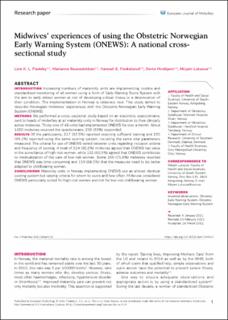| dc.contributor.author | Fladeby, Line K Løberg | |
| dc.contributor.author | Raunedokken, Marianne | |
| dc.contributor.author | Fonkalsrud, Hannah Elisabet | |
| dc.contributor.author | Hvidtjørn, Dorte | |
| dc.contributor.author | Lukasse, Mirjam | |
| dc.coverage.spatial | Norway | en_US |
| dc.date.accessioned | 2021-12-15T14:44:33Z | |
| dc.date.available | 2021-12-15T14:44:33Z | |
| dc.date.created | 2021-05-03T14:08:51Z | |
| dc.date.issued | 2021-04 | |
| dc.identifier.citation | European Journal of Midwifery. 2021, 5 (4), 1-9. | en_US |
| dc.identifier.issn | 2585-2906 | |
| dc.identifier.uri | https://hdl.handle.net/11250/2834531 | |
| dc.description.abstract | Introduction: Increasing numbers of maternity units are implementing routine and standardized monitoring of all women using a form of Early Warning Score System with the aim to early detect women at risk of developing critical illness or a deterioration of their condition. The implementation in Norway is relatively new. This study aimed to describe Norwegian midwives’ experiences with the Obstetric Norwegian Early Warning System (ONEWS). Methods: We performed a cross-sectional study based on an electronic questionnaire, sent to heads of midwifery at all maternity units in Norway for distribution to their clinically active midwives. Thirty-one of 48 units had implemented ONEWS for over a month. About 1020 midwives received the questionnaire, 232 (23%) responded. Results: Of the participants, 217 (93.5%) reported receiving sufficient training and 230 (99.1%) reported using the same scoring system, including the same vital parameters measured. The criteria for use of ONEWS varied between units regarding inclusion criteria and frequency of scoring. A total of 214 (92.2%) midwives agreed that ONEWS has value in the surveillance of high-risk women, while 152 (65.5%) agreed that ONEWS contributes to medicalization of the care of low-risk women. Some 166 (71.6%) midwives reported that ONEWS was time consuming and 159 (68.5%) that the measures need to be better adapted to childbearing women. Conclusions: Maternity units in Norway implementing ONEWS use an almost identical scoring system but varying criteria for whom to score and how often. Midwives considered ONEWS particularly suited for high-risk women and not for low-risk childbearing women. | en_US |
| dc.language.iso | eng | en_US |
| dc.publisher | European Publishing | en_US |
| dc.relation.ispartofseries | European Journal of Midwifery;April/2021 vol. 5 | |
| dc.rights | Navngivelse-Ikkekommersiell 4.0 Internasjonal | * |
| dc.rights.uri | http://creativecommons.org/licenses/by-nc/4.0/deed.no | * |
| dc.subject | Maternal observations | en_US |
| dc.subject | Obstetric early warning systems | en_US |
| dc.subject | Obstetric norwegian early warning systems | en_US |
| dc.title | Midwives’ experiences of using the Obstetric Norwegian Early Warning System (ONEWS): A national cross-sectional study | en_US |
| dc.type | Peer reviewed | en_US |
| dc.type | Journal article | en_US |
| dc.description.version | publishedVersion | en_US |
| dc.rights.holder | © 2021 Fladeby L. K. L. et al. | en_US |
| cristin.ispublished | true | |
| cristin.fulltext | postprint | |
| cristin.qualitycode | 1 | |
| dc.identifier.doi | https://doi.org/10.18332/ejm/134510 | |
| dc.identifier.cristin | 1907801 | |
| dc.source.journal | European Journal of Midwifery | en_US |
| dc.source.volume | 5 | en_US |
| dc.source.issue | 4 | en_US |
| dc.source.pagenumber | 1-9 | en_US |

